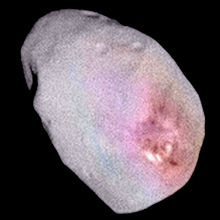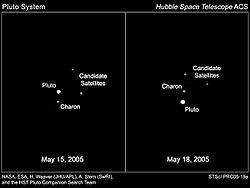Nix (moon) - Simple English Wikipedia, the free encyclopedia
 The highest-resolution image of Nix, taken by New Horizons on 14 July 2015. Image captured in grayscale by LORRI, color added based on other images from Ralph MVIC. | |
| Discovery | |
|---|---|
| Discovered by | Hubble Space Telescope Pluto Companion Search Team |
| Discovery date | 15 June 2005 |
| Designations | |
| Pronunciation | /ˈnɪks/ |
Named after | Nyx |
| (134340) Pluto II[1] | |
| Adjectives | Nictian |
| Orbital characteristics[3] | |
| 48694±3 km | |
| Eccentricity | 0.00000[2] |
| 24.85463±0.00003 d | |
| Inclination | 0.133°±0.008° |
| Satellite of | Pluto |
| Physical characteristics | |
| Dimensions | ≈ 50 km × 35 km × 33 km[4] |
| Mass | (4.5±4.0)×1016 kg[2] |
| 1.829 ± 0.009 d[4] chaotic[5] (increased by 10% between discovery and flyby)[6] | |
| 132°[6] (to orbital plane; July 2015) | |
| Albedo | 0.56 ± 0.05 geometric[4] |
| Temperature | 33–55 K |
| 23.38–23.7 (measured)[7] | |

Nix is a non-spherical moon of Pluto. It was found along with Hydra in June 2005 by the Hubble Space Telescope Pluto Companion Search Team.
The discovery images were taken on May 15, 2005 and May 18, 2005; the moons were independently found by Max J. Mutchler on June 15, 2005 and Andrew J. Steffl on August 15, 2005. The discoveries were announced on October 31, 2005, after confirmation from photographs archived in 2002. The moon were designated S/2005 P 1 (Hydra) and S/2005 P 2 (Nix).[8][9]
The moon follows a circular orbit in the same plane as Charon. It takes 24.9 days to circle around Pluto.
Before its size was directly measured, the moon was calculated to have a diameter of between 46 km, if its reflectivity is similar to Charon's 35%, and 137 km, if it had a reflectivity of 4%, like the darkest Kuiper belt objects.[10] Nix is slightly fainter than Hydra, suggesting that it is somewhat smaller in size.[7] In the discovery image, Nix is 6,300 times fainter than Pluto.[11]
Early research appeared to show that Nix was reddish like Pluto and unlike the other moons,[12] but more recent reports have been that it is grey like the remaining moons.[7]
Nix was visited along with Pluto by the New Horizons mission in 2015.
The formal name "Nix", from the Greek goddess of darkness and night, and mother of Charon, was announced on June 21, 2006 on IAU Circular 8723,[9] where the designation Pluto II is also given. Together with Hydra, Pluto's third moon, the initials are those of the New Horizons probe. The initial proposal was to use the Classical spelling Nyx, but to avoid confusion with the asteroid 3908 Nyx, this was changed to "the Egyptian spelling of the Greek name".[13]
References
[change | change source]- ↑ Jennifer Blue (2009-11-09). "Gazetteer of Planetary Nomenclature". IAU Working Group for Planetary System Nomenclature (WGPSN). Retrieved 2010-08-30.
- ↑ 2.0 2.1 Stern, S. A.; Bagenal, F.; Ennico, K.; Gladstone, G. R.; et al. (15 October 2015). "The Pluto system: Initial results from its exploration by New Horizons". Science. 350 (6258): aad1815. arXiv:1510.07704. Bibcode:2015Sci...350.1815S. doi:10.1126/science.aad1815. PMID 26472913. S2CID 1220226.
- ↑ Showalter, M. R.; Hamilton, D. P. (3 June 2015). "Resonant interactions and chaotic rotation of Pluto's small moons". Nature. 522 (7554): 45–49. Bibcode:2015Natur.522...45S. doi:10.1038/nature14469. PMID 26040889. S2CID 205243819.
- ↑ 4.0 4.1 4.2 "2016 Lunar & Planetary Science Conference by National Institute of Aerospace". Archived from the original on 2018-06-23. Retrieved 2018-02-16.
- ↑ Northon, Karen (3 June 2015). "NASA's Hubble Finds Pluto's Moons Tumbling in Absolute Chaos".
- ↑ 6.0 6.1 "DPS 2015: Pluto's small moons Styx, Nix, Kerberos, and Hydra [UPDATED]". www.planetary.org.
- ↑ 7.0 7.1 7.2 Stern S.A.; et al. (2006). "The Positions, Colors, and Photometric Variability of Pluto's Small Satellites from HST Observations 2005-2006". Astronomical Journal: submitted. (Final preprint)
- ↑ IAU Circular No. 8625 describing the discovery
- ↑ 9.0 9.1 IAU Circular No. 8723 naming the moons
- ↑ H. A. Weaver; S. A. Stern; M. J. Mutchler; A. J. Steffl; et al. (23 February 2006). "Discovery of two new satellites of Pluto". Nature. 439 (7079): 943–945. arXiv:astro-ph/0601018. Bibcode:2006Natur.439..943W. doi:10.1038/nature04547. PMID 16495991. S2CID 1456215.
- ↑ Brightness Difference on 2005-05-15: (5th root of 100) ^ (Nix APmag 23.38 - Pluto APmag 13.87) = 6,368x
- ↑ Buie, Marc W.; Grundy, William M.; Young, Eliot F.; Young, Leslie A.; Stern, S. Alan (2006). "Orbits and Photometry of Pluto's Satellites: Charon, S/2005 P1, and S/2005 P2". Astronomical Journal. 132 (1): 290–298. arXiv:astro-ph/0512491. Bibcode:2006AJ....132..290B. doi:10.1086/504422. S2CID 119386667.(Final preprint) a, i, e per JPL (site updated 2008 Aug 25)
- ↑ "Planet and Satellite Names and Discoverers". Gazetteer of Planetary Nomenclature. USGS Astrogeology. July 21, 2006. Retrieved 2006-08-15.
Other websites
[change | change source]- Nix Profile Archived 2007-08-01 at the Wayback Machine by NASA's Solar System exploration
- Background information regarding our two newly discovered satellites of Pluto – The discoverers' website
- NASA's Hubble reveals possible new moons around Pluto – Hubble press release
- Two more moons discovered orbiting Pluto (SPACE.com)
- Pluto's newest moons named Hydra and Nix (SPACE.com)
- [Steffl A.J. (2006). "New constraints on additional satellites of the Pluto system". The Astronomical Journal. 132 (2): 614–619. arXiv:astro-ph/0511837. Bibcode:2006AJ....132..614S. doi:10.1086/505424. S2CID 10547358.(Final preprint)


 French
French Deutsch
Deutsch